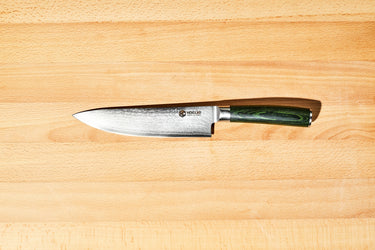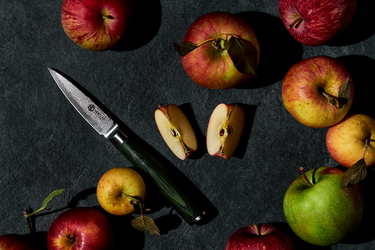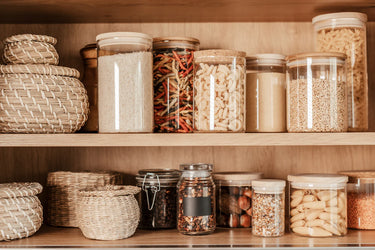5 Knife Handle Materials Designed for the Kitchen

You may know a good bit about knife blade material, but what about knife handles?
While we typically give most of our attention (understandably!) to the part of the knife that connects with our ingredients to do the actual cutting, we shouldn’t underestimate the importance of the knife’s handle.
Our 5 Favorite Knife Handle Materials
The part of the knife we grip not only affects how comfortable the knife is to work with, but also plays a role in the knife's strength, balance, safety, aesthetics, and overall performance. Who knew?
There are all sorts of knife handles available: wood handles, bone handles, carbon fiber handles, micarta handles, glass handles, stainless steel handles — the list goes on.
So what should you look for when choosing a knife handle? Here are a few of our favorites.
1. Pakkawood
Pakkawood is a type of engineered composite that combines natural wood with a resilient resin laminate to create high quality, durable knife handles.
Pakkawood knives typically have a wooden core surrounded by layers of laminated hardwood. Like an onion, these thin outer layers provide a protective barrier that keeps the inner core safe and the structural integrity intact.
To create the resilient outer layers, the wooden veneer is manually transformed through thermosetting. During this process, any moisture is removed from the plywood, and then the wood is infused with epoxy resin and heated under high pressure.
Compressing the materials allows the resin to harden as the materials bind together, forming a new type of wood-based material that is visually striking with unique patterns and colors based on the specific mix of wood and dyes used.
The phenolic wood is ground and polished, ensuring the handle is waterproof, durable, and dense without compromising its beauty.
2. Carbon Steel
Carbon steel is a type of metal alloy rich in carbon. All metal contains the elements iron and carbon, but the carbon content can vary from one type of steel to another. The more carbon content, the stronger and harder the material is.
Carbon steel contains the highest carbon content, creating a sturdy metal that is ultra-lightweight and less likely to crack and break than other types of steel. This is because the carbon shifts the crystal lattice of the steel to make it less fragile.
Historically, carbon steel was used to craft elegant and resilient Japanese swords. Today, it is a versatile and multipurpose material commonly used for knife blades, handles, and cookware.
But, there are downsides to opting for carbon steel cutlery. Without the same chromium protective layer that stainless steel contains, carbon steel is more prone to rust and corrosion when exposed to moisture.
This can be tricky to navigate, as moisture is an inevitable part of the kitchen. If you accidentally leave a carbon steel knife in the sink, if you forget to dry it immediately after washing it, or keep it too close to the steam as you cook, the moisture may lead to damaged handles.
While carbon steel handles are lightweight and easy to handle, the extra care required to keep them rust-free and in tip-top shape is more than many home chefs care to stress about. After all, we already have enough on our plates, don’t we?
3. Titanium
Titanium is a strong and lightweight chemical element that is naturally present in the earth's crust, water, and rocks. When reduced and polished, it can serve as a silvery-gray and lustrous metal alloy with various uses ranging from ship and aircraft construction to material for prosthetics or kitchen knives.
Titanium knife handles are extremely rust-resistant due to the formation of a passive oxide surface film around the alloy. This means that you don’t have to worry about overexposing them to moisture.
Titanium is also less dense than iron or aluminum, making it a lightweight option — although not quite as light as carbon steel.
Some chefs prefer the comfortable feel of titanium handle scales. Because titanium is not a very good conductor of heat, it does not pull heat from the hands during use and therefore typically remains pleasantly warm to the touch.
This also makes titanium an ideal material for outdoor knives such as pocket knives or folding knives.
But although very durable, rust-resistant, and comfortable, titanium is also more prone to abrasion through everyday wear and tear, meaning it can become scratched and scuffed more easily than other materials.
The anodization process for titanium can produce a wide range of textures and unique colors that make titanium a popular option for the handle liner material of custom knives and collectibles, but they may not be the best option for your go-to kitchen knives.
Titanium will likely obtain scratches during regular use, which can diminish the look of even the nicest handles.
4. Aluminum
A silvery-white metal alloy, aluminum is a common and affordable low-density material used for kitchen knives and handles.
While not as strong an alloy as carbon steel, stainless steel, or titanium, aluminum undergoes an anodization process to enhance its durability. This process involves coating the aluminum with a layer of oxide via an electrolytic process, which increases the metal’s hardness.
Anodizing aluminum can also add rust resistance and color, making these relatively inexpensive knife handles a fun way to add a pop of color to your space.
However, aluminum is a good conductor of heat, which means it can feel cold to the touch as it absorbs the heat from our skin. The anodized metal can also be potentially slippery (not quite what we want out of our knife handles) and prone to scratching.
5. G-10 Garolite
G-10 Garolite is a type of engineered material made from fiberglass. This laminate composite contains layers of fiberglass cloth soaked in resin and then compressed and baked under pressure.
The combination of fiberglass and resin leads to an ultra-sturdy and hard material that is still lightweight.
The G-10 grade of garolite is believed to outrank micarta knives–another engineered material made with linen cloth rather than fiberglass cloth–in terms of durability. G-10 garolite is also water resistant, as it is a non-porous material.
The knife-making tools used to create G-10 handles can incorporate checkered patterns and textures to the handle to elevate their comfort and grip-ability. These handles are often aesthetically pleasing as well since the fiberglass layers used for each handle can include a range of colors to create intricate designs.
The downside is that, while lightweight and sturdy, the G-10 garolite is somewhat brittle and more likely to crack than other common handle materials (not the best trait to find in a knife handle).
What Are the Benefits of a Pakkawood Knife Handle?
Here at HexClad, we craft the handle scales for all of our full-tang Damascus steel knives with pakkawood. Wondering why pakkawood is our go-to? Let’s take a deeper look at this mighty material.
Unique Scaled Pattern
The resin used for pakkawood handles can include various dyes for a unique, colorful, or traditional look. And the scaled pattern formed by the layers of wood provides a touch of natural allure and beauty.
Pakkawood handles also undergo sanding and polishing to achieve a glossy and scratch-resistant finish that doesn’t compromise the design formed by the layers of the natural wood.
At HexClad, our pakkawood knife handle scales are a rare forest green you can proudly display in any kitchen. The striking color and pattern of the handles make our culinary knife set fit for the most elegant gatherings.
Comfortable Grip
During the thermosetting process used to create pakkawood handles, the material can be molded into a wide range of shapes to create a comfortable and supportive grip. The resin finish is also not a conductor of heat, meaning your knife handle will stay at room temperature rather than feeling cold to the touch, as certain metal handles may.
Pakkawood also offers a solid balance of weight for easy use, and the material is unlikely to become slippery in your hands. Safety first!
Heat Resistance
The thermosetting process allows pakkawood to become resistant to heat and moisture, which often occur during the cooking process. Pakkawood’s heat resistance occurs due to a shift in the material’s molecular structure when exposed to the high heat and pressure of the thermosetting process.
This curing process is capable of changing the molecular structure of the epoxyphenolic resin by causing its polymer chains crosslink to form stronger bonds. The revamped bonds are then strong enough that they cannot ever break back down to their original structure, even when exposed to high heat in the future.
It’s sort of like an egg: while originally a liquid substance, an egg begins to solidify once you place it on a hot skillet. The heat changes the egg's molecular structure, and it cannot melt back down into a liquid.
Similarly, pakkawood cannot melt back down to its pre-thermoset state and is, therefore, more resistant to heat and temperature changes than materials that haven’t undergone this molecular change.
Made With Hardwood and Plastic for Extra Strength
The infusion of hardwood and plastic resin creates a durable material specifically engineered to withstand heavy use, force, and high heat. A dynamic duo, the merging of wood and plastic creates a sturdy material that provides more strength than either one does on its own.
The durable pakkawood is not only heat resistant but also resilient against rust, abrasion, and water.
While wood is naturally porous and therefore susceptible to water damage, the resin used to form pakkawood creates a non-porous waterproof finish that simplifies the cooking and cleaning process.
With no metal or exposed wood, there's no need to worry about your handles becoming rusted or water damaged.
And because the resin finish is also less prone to scratching and denting, pakkawood handles are built to last — capable of withstanding daily use, long hours of holiday cooking, and even the occasional but unavoidable fall.
Less Prone to Splitting Than Natural Wood
Wood has played a role in knifemaking for centuries. From exotic wood to zebrawood to ironwood to burl wood, crafting knives with natural wooden handles is a practice with deep roots in history.
But, while traditional wooden handles are enchanting, warm, and comfortable to hold, they are also more prone to damage.
Unfinished wood is relatively delicate and susceptible to the elements. Wood can warp or rot when exposed to water, and can start to crack and split under pressure — or simply through regular use over time.
By forming stabilized wood with the inclusion wood with resin, pakkawood can outlive traditional wooden handles. The non-porous material isn’t prone to splitting or discoloration, and the polished finish creates a smooth and glossy finish that is easy to clean and won’t invite bacteria, even when exposed to moisture.
With a hardwood core protected by resin, pakkawood knife handles provide the same classic charm as wooden handles without the risk of splitting or warping over time.
HexClad Knives: Function and Style for the Modern Kitchen
Here at HexClad, we design our knives to provide long-lasting support in the kitchen — and to look good doing it for years to come. All of our knives are forged from 67 layers of high-quality Japanese Damascus steel for effortless and precise slicing and dicing.
The full-tang construction and steel bolster provides superior balance and safety by limiting the risk of slipping. And, of course, the rare forest green pakkawood handle adds a unique touch. They are durable yet comfortable to hold.
The waving pattern of the layered steel blade compliments the scaled pattern of the pakkawood handle for an overall striking display that adds a statement to any kitchen and looks perfect on any table.
Ready to upgrade your collection? We thought so. You can find the HexClad Essential Six Piece Knife Set with Block and our collection of sleek steak knives, along with our other versatile hybrid cookware, all in our online store.
Sources:
Thermal Conductivity Measurements of Proton-Heated Warm Dense Aluminum | Scientific Reports





